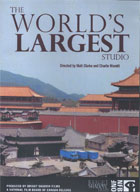
The World's Largest Studio 2007
Distributed by National Film Board of Canada, 1123 Broadway, Suite 307, New York, NY 10010; 800-542-2164
Produced by Charlie Moretti
Directed by Matt Clarke and Charlie Moretti
DVD , color, 52 min.
Jr. High - Adult
Asian Studies, Film Studies, Media Studies, Museums, Travel and Tourism
Date Entered: 12/02/2009
Reviewed by Maureen Donovan, The Ohio State UniversityThe World's Largest Studio is a documentary film introducing Hengdian World Studios, the vast film studio complex, theme park, and acting school located in the countryside of Zhejiang Province, about 350 kilometers from Shanghai. Growing quickly from concept stage in 1996 to realization four months later in a lavish set for the filming of The Opium War, Hengdian is the cornerstone enterprise of the Hengdian Group, a private corporation founded by Xu Wenrong, with enterprises in electronic products, medical products and entertainment, which has close ties to the Chinese government.
The film provides an overview of Hengdian World Studios' varied operations, beginning with the arrival of local people (who continue to be employed as gardeners) in the early morning, and proceeding through many scenes at shooting locations at Hengdian and nearby places throughout the day and evening, and concluding with a group of actors talking about the differences between Hengdian and Hollywood and other matters into the wee hours past midnight.
While not delving into such matters deeply, The World's Largest Studio provides insights into the intersections of politics, propaganda, and entertainment in China. It would be useful, therefore, as background and stimulus to class discussions of Chinese films, especially of historical dramas produced at Hengdian, such as Zhang Yimou's Hero (2002), or a Chinese martial arts film.
The film introduces the reconstructed village of Sha Jia Bang, the setting of a famous modern Beijing Opera written during the Cultural Revolution and named after the village, which tells a heroic story of resistance against the Japanese in 1939. While not really stressing it, the film shows the importance that such "model dramas" continue to have in China's cultural life.
Among other places, we visit a large, outdoor museum that was constructed by the Hengdian Group to memorialize the Luding Bridge Battle between the Red Army and the Guomindang during the Long March (1935), which serves as a stage for reenactments of the battle, attracting tourists. Tourism produces about twenty percent of Hengdian World Studios' annual income. The management of Hengdian views its role in teaching history as an important part of its mission. A professor of history from Beijing University trains guides who lead tourists through the accurately reconstructed Forbidden City, the most impressive film setting at Hengdian, for example.
The World's Largest Studio does not only introduce the corporation and settings at Hengdian. We also meet and observe many people who work there, including actors, managers, directors, guides, teachers, choreographers, monks (at a Buddhist temple site), and film crew members, numbering thirty or more for a single shoot.
All in all, The World's Largest Studio captures a moment in time. Filmed about ten years after the founding of this extraordinary enterprise, it documents Hengdian as it was in about 2007. A visit to the Hengdian World Studios web site in 2009 reveals that its facilities continue to expand, as it attracts ever more filmmakers to take advantage of all that it offers.